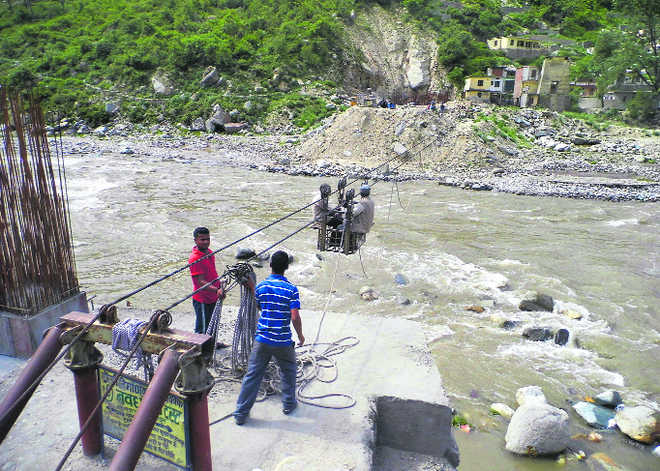
Villagers near Rudraprayag have to cross a stream through a trolley. The chopper parked at a helipad in Rudraprayag.
Ajay Ramola in Rudraprayag
The June 2013 tragedy caused by landslides and swollen rivers in Uttarakhand killing thousands of people (over 5,000 as no exact count is available) should have driven any government to seriously take up the ecological challenge and concretize plans on the ground to obviate such a calamity. But no prizes for guessing as to what the government has “achieved:” it has made the Kedarnath yatra a profitable venture and pushed the more important, daunting task of building roads and environmentally sustainable infrastructure to the back burner.
Government officials these days are overanxious to tell everyone who matters that the pilgrim count this year has crossed the 10-lakh mark, and that helicopter services are the new in-thing for facilitating “quick darshan” at Kedarnath. This quick-fix solution has nothing to do with the people living there, nor does it address the most significant question: How to make the hill state a safer place to live in? Here are ground realities that both the state government and the Centre refuse to see:
More than nine helicopter service agencies are making a killing as they charge Rs 7,000 per person per visit. The seats for the ride to the Kedarnath shrine are booked three months in advance. The fallout: A new ‘darshan’ culture. Keshav Tiwari, a member of the temple priest community, says pilgrims being ‘airdropped’ are given special ‘darshan.’ The helicopter service agencies are in a rush to ferry batches from Ukhimath. So, they tie up with the Badri Kedar Mandir Samiti which also offers pilgrims chopper tickets and a free passage to the shrine, sidelining others who walk to the shrine and queue up for hours. The Centre under its National Mission on Pilgrimage Rejuvenation and Spiritual Augmentation Drive (PRASAD) provided funds worth Rs 7.87 crore for integrated development of tourism infrastructure at Ukhimath and surrounding areas on way to Kedarnath. These included Tourist Reception and information Centre, kiosks, gender-based wayside amenities, rain shelter, solid waste management, informatory signs in Rudraprayag apart from thousands of crores that the district received for restoration work at Kedarnath. Many of these plans remain only on paper.
What about landslides?
Uttarakhand has to contend with landslides and a pathetic road network. But the state government has chosen to ignore sustainable solutions and ecologically sound techniques for building infrastructure. In the aftermath of the tragedy, and even much later, several bridges had caved in due to faulty techniques. Many bridges were reconstructed, but the district administration has not taken into account the design aspect. The consequences can be very serious: in case of a landslide, it would be the “profitable’ Char Dham yatra that could be affected the most. KK Kapila, chairman, Geneva-based International Road Federation (IRF) and co-chairman FICCI Transport Infrastructure Committee, emphasizes that the fragile terrain of the young and active Himalayas in Uttarakhand need a non-destructive and least invasive techniques to build roads.
Power projects on the rivers in Uttarakhand have been blamed for triggering the disaster but it seems that no lessons have been learnt. The 99 MW projects owned by LANCO and L&T at Berubagad were blamed for widespread landslides, but these have been given the go-ahead despite protests from environmentalists. Mukesh Semwal, the state convener Social Unity Centre of India, said: “Some firms used dynamite to blast the rocks for constructing an 11-km tunnel from Kund to the power station at Berubagad on the Mandakini river. This resulted in landslides and cracks in the houses.”
The damage to ecology is of such an extent that the whole panchayat forest land has caved in. The local women headed by Sushila Bhandari carried out a movement against power projects without much success.
Helicopter services to Kedarnath, too, are under the environmental scanner. Suresh Bhai, the founder of Nadi Bachao Andolan, says plying of helicopters in the national sanctuary area is a violation of environment laws. “The silence of the wildlife department indicates that there is some collusion at higher level.”
Keshav Tiwari, a social activist from Kedarnath, says chopper rides do not contribute to the local economy. “Pony owners and various tea vendors along the way to the shrine are becoming jobless,” he said.



























